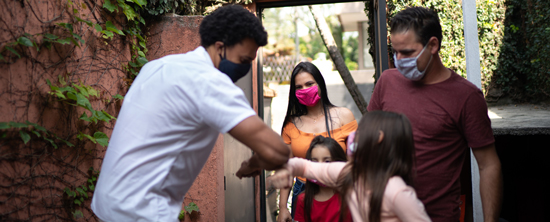
We're making fantastic progress with increasing the number of people who are vaccinated and decreasing community transmission rates of COVID-19. However, herd immunity is still a ways off.
If you have not been vaccinated, please reconsider the pros and cons of getting a COVID-19 vaccine. The COVID-19 vaccine protects you, your family and our community. All the COVID-19 vaccines are free, very effective and very safe.
Fully vaccinated people can resume most activities. If you're not fully vaccinated, the risks of getting and spreading COVID-19 remain present.
Those at higher risk should certainly be more cautious, but young and otherwise healthy individuals can get sick too. We should all act responsibly to avoid putting others in harm's way.
If you aren't fully vaccinated, here are seven ways to recognize risky COVID-19 situations:
1. You're finding it hard to stay at least 6 feet away from others.
A safe situation is one where you can maintain at least 6 feet of space between yourself and people you don't live with. Droplets produced by talking, coughing or sneezing generally carry approximately 6 feet. Airborne droplets can travel farther.
2. People aren't wearing masks.
Masks serve two purposes:
- They protect you from exposure
- They also prevent you from spreading the virus to others if you are asymptomatic or presymptomatic
Any two or three-ply cotton mask that covers the nose and mouth will work. Wash your hands before you put on your mask and after you take off your mask. If you wear a reusable mask, wash it regularly.
If you are returning to work in a shared office space, wearing a mask is a good idea if everyone is not fully vaccinated. If you are working in a private office, it's okay to take off the mask when you're alone in your office. Just be sure to wear it when using common spaces like bathrooms, hallways and breakrooms.
If you are wearing a mask, but others around you aren't, you're still in a risky situation, so be extra cautious.
3. You're inside.
Outdoor activities are much safer than indoor activities. A study of more than 7,300 cases in China shows that just one case was linked to outdoor transmission.
For example, playing golf in a small group outside is less risky than practicing yoga with a small group in an enclosed room. And eating inside a restaurant is much riskier than eating outside. If you are going to a restaurant, pick one with outdoor seating.
4. You're having contact with people you don't live with.
Sustained contact (more than 15 minutes) is a higher risk situation than brief contact. For example, stopping to talk to someone is much riskier than just walking by and waving hello.
5. There are a lot of people around.
We are all craving social interaction, but please avoid large social gatherings. Try to restrict your circle to a small group of people you trust. Fully vaccinated guests are much less likely to spread COVID-19.
If you absolutely must host a social gathering, take precautions to minimize risk:
- Limit your guest list to 10 people or less
- Hold gatherings outside
- Place chairs or tables 6 feet apart
- Ask guests to bring their own coolers with beverages and snacks
- Reserve a designated bathroom for guests
- Put out disposable paper towels rather than a cloth towel
- Have disinfectant wipes available to wipe the area after use
6. People are yelling, laughing or singing without masks on.
Talking, yelling, exercising and singing can spread infected respiratory droplets. Any time inhaling and exhaling occur there is potential to spread the virus.
Singing and yelling aerosolize respiratory droplets, or convert them into a fine spray. Follow that with deep breathing, and you can start to understand how easy it is for tiny viral droplets to invade your lungs.
7. Food is laid out on tables and counters or isn't individually served.
People sharing food utensils and congregating around areas where food is laid out can pose a risk. Try to avoid buffet-style serving situations. And if you plan to attend a gathering where this is happening, consider eating before you go or bring your own snacks and drinks.

Guidelines from the CDC as of May 14 show that fully vaccinated people can safely resume many activities.


